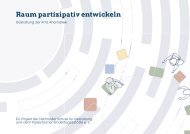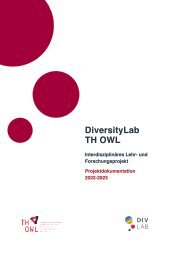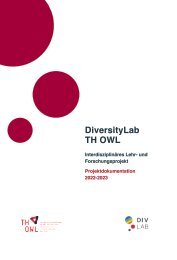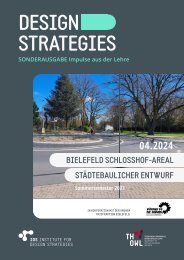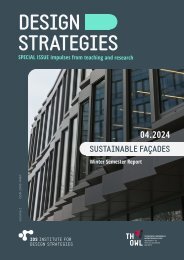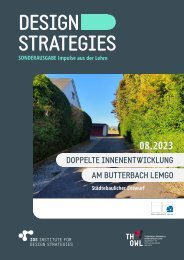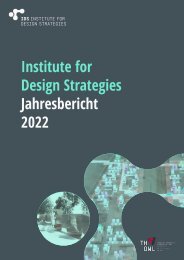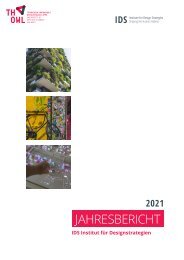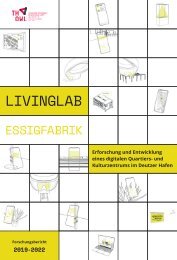urbanLab Magazin 2021 - Transformation
Erfolgreiche ePaper selbst erstellen
Machen Sie aus Ihren PDF Publikationen ein blätterbares Flipbook mit unserer einzigartigen Google optimierten e-Paper Software.
Interactive model and second screen in the background<br />
with all three parameters can estimate<br />
the number of cars of the incomplete<br />
dataset.<br />
In this case, a travel survey with activity<br />
tables and types of people is used<br />
to train a network that later splits the<br />
social media users into different groups<br />
of citizens according to their activity<br />
patterns. These profiles are then used<br />
to populate the model, with the use of<br />
social media working as a form of early<br />
user participation, for allowing planners<br />
to use a bigger and more updated set of<br />
citizen’s data than traditional surveys,<br />
while of course respecting the privacy<br />
of the social media users, who are kept<br />
anonymous.<br />
2 AGENTS<br />
Agent-based models (ABMs) are used<br />
in multiple fields to simulate complex<br />
systems through a set of independent<br />
agents that follow certain rules and react<br />
on an environment. In urban planning,<br />
activity-based travel demand<br />
models (ABTDM) are used to estimate<br />
the demand for travel in a region and<br />
the resulting performance of the transportation<br />
system, according to different<br />
scenarios and policy, economic,<br />
demographic or land use changes, as<br />
defined by Castiglione et. al (2014) in<br />
“Activity-Based Travel Demand Models:<br />
A Primer”. They also define the focus of<br />
these models as “whether, when, and<br />
where to participate in activities and for<br />
how long. Travel is a derived demand<br />
resulting from the need for people to<br />
engage in activities outside the home”.<br />
This need for travelling and engaging<br />
in activities has also been connected<br />
to quality of urban spaces. In “Life Between<br />
Buildings”, Gehl (1987) writes that<br />
in public spaces of poor quality, people<br />
only pass by on the way to necessary<br />
activities that they must do, like going to<br />
work or shopping. On the other hand, if<br />
the public space is of good quality, people<br />
start engaging in more optional activities,<br />
such as taking a walk or sitting on<br />
a bench. People attract more people,<br />
and so social activities, that result from<br />
the presence of others, such as just<br />
watching people passing by, also arise.<br />
Jane Jacobs (1961), in “The Death and<br />
Life of Great American Cities”, connects<br />
urban vitality to diversity in the built<br />
environment. For an urban space to be<br />
successful and safe, a diversity of people<br />
should pass by it, with different purposes,<br />
and in different times of the day.<br />
Based on these theories, an ABTDM is<br />
used to measure the urban vitality of<br />
the public spaces in the district, based<br />
on the activity and travelling patterns<br />
of the population, which were already<br />
described.<br />
Using the Shannon entropy index, a formula<br />
used to calculate diversity as part<br />
of the communication theory (Shannon,<br />
1948), it is possible to measure different<br />
132 STUDENT IDEAS






